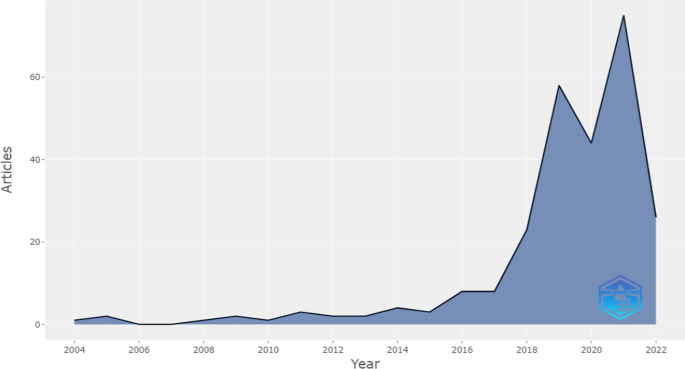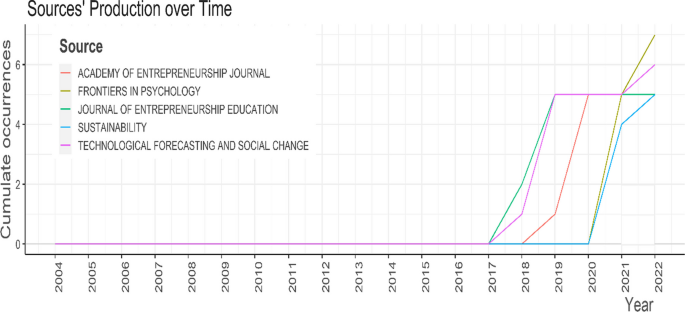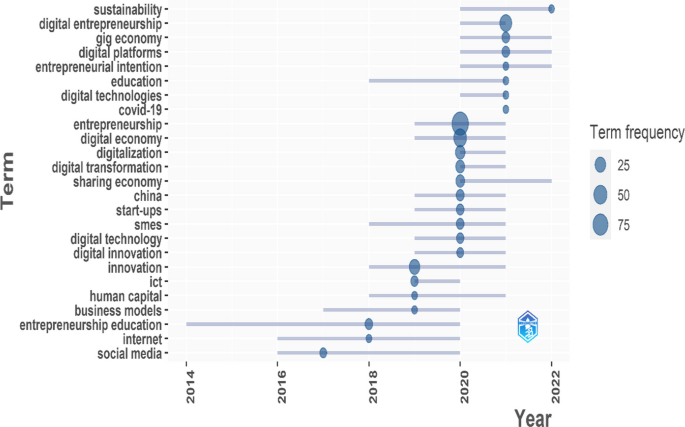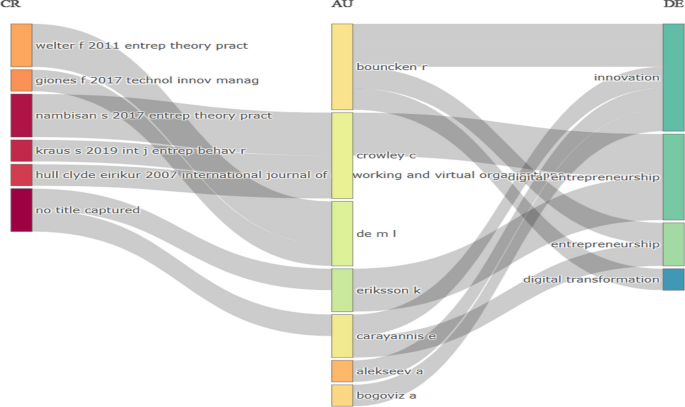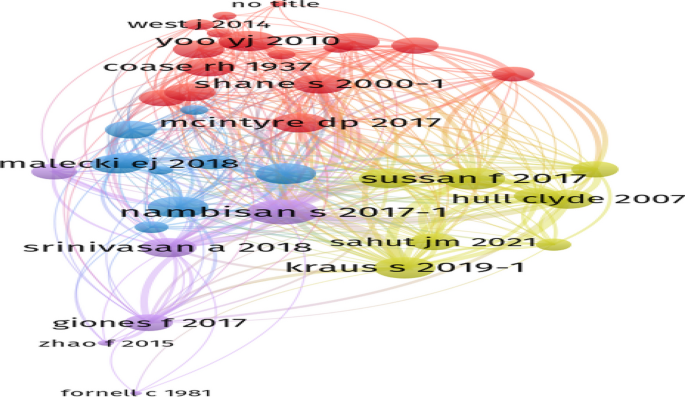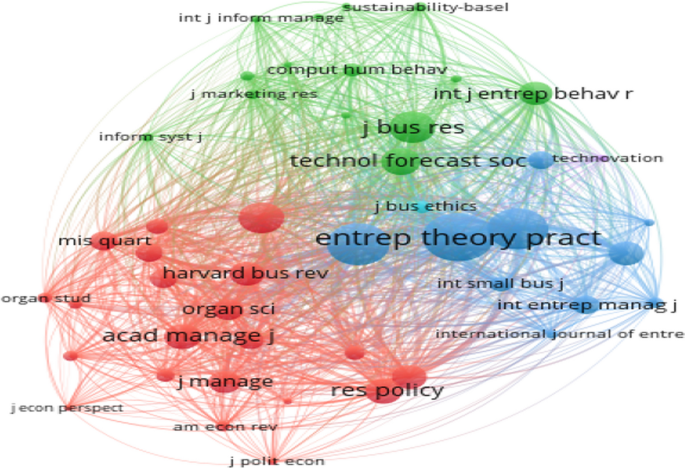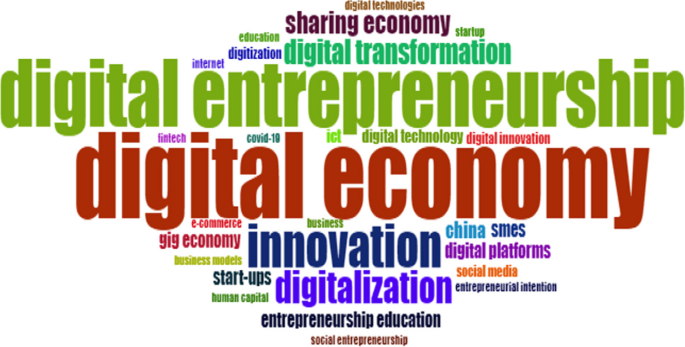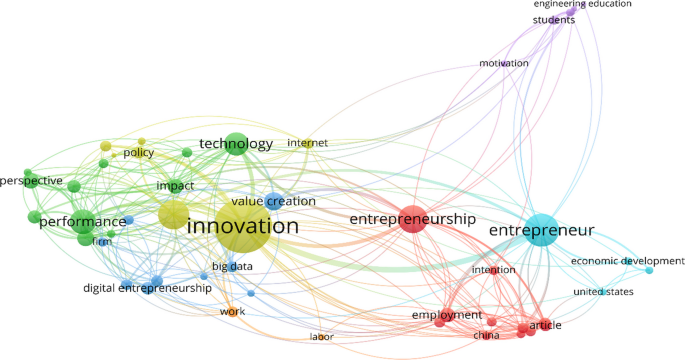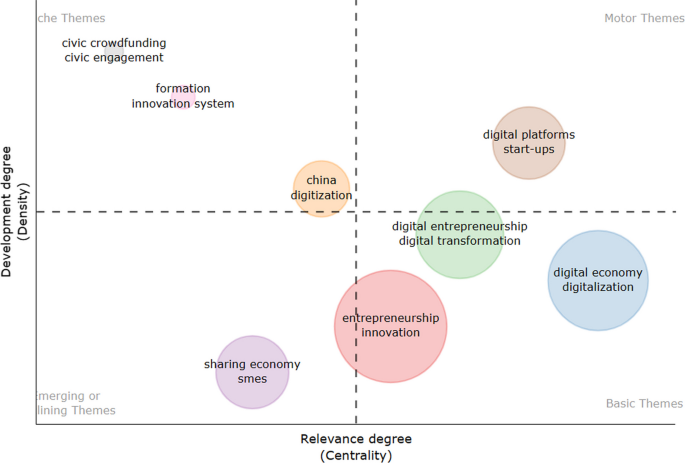A scientometric analysis of entrepreneurial and the digital economy scholarship: state of the art and an agenda for future research


Performance analysis
The first analysis reveals a summary of the performance of the selected publications, as presented in Table 2.
Table 2 shows that the selected papers have been published between 2004 and 2022 and referenced in 198 sources. The average age of a paper is 2.83 years, with an average citation rate of almost 17 per paper. The number of references included in the 198 sources is approximately 14,364. A total of 776 authors contributed to these publications, which included 1090 keywords. The average number of authors per publication is almost equal to 3, with 49 publications compiled by a single author. The level of collaboration between the theme authors measured by the collaboration index is equal to 3.22 (Donthu et al., 2021).
Figure 2 represents the annual scientific production on entrepreneurship and the digital economy from 2004 to 2022.
Annual publications on entrepreneurship and the digital economy (2004–2022)
The temporal evolution analysis concerning publications on entrepreneurship and the digital economy theme (Fig. 2) reflects a significant increase in 2016 from 4 to 8 papers per year. This was also the year the OECD held the discussion meeting on “Skills for a Digital World”, which provided new evidence on the effects of digital technologies on demand for future skills and presented key policies to foster skills development for the digital economy (Skills for a Digital World, 2016). In addition, the year 2018 recorded an escalation in the number of publications from 8 to 23, reaching a peak of 75 publications in 2021. This huge spike in publications highlights the importance and interest in this topic. This evolutionary analysis was conducted using the annual percentage growth rate of 19.84216 papers.
Figure 3 depicts the production evolution of the 5 most productive sources involving the theme of entrepreneurship and the digital economy.
Production evolution of the 5 most productive sources (minimum 4 papers)
Figure 3 illustrates the production evolution of journals, including a minimum of 4 publications dealing with the entrepreneurship and digital economy theme. Frontiers in Psychology published 7 papers (5 in 2021 and 2 in 2022). Interestingly, this journal focuses on psychological sciences. This provides evidence that entrepreneurship and the digital economy have a strong human-based psychological context and that studies on this topic strongly focus on our ability as humans to develop new intervention methods. The second most productive journal is Technological Forecasting and Social Change, with 6 papers published between 2018 and 2022. This journal focuses on technological forecasting and future studies serving as a planning mechanism to connect environmental, social, and technological aspects. The 5 sources, mentioned in Fig. 3, began publishing papers on the current research theme in 2018.
However, it should be stressed that the first paper on the theme by Lewis et al. (2004) appeared in the journal of Management Decision, which focuses on advancing the field of management with original, informative content and clear implications for business scholars, leaders, and professional managers on a global scale.
Table 3 depicts the top 10 most cited sources that focus on the theme of entrepreneurship and the digital economy.
Table 3 Top 10 most cited sources on entrepreneurship and the digital economy
Table 3 shows that the Small Business Economics, Entrepreneurship Theory and Practice, and the Journal of Business Venturing were cited most, each exceeding 100 citations.
Table 4 presents the rankings of the top 10 journals by performance measures.
Table 4 Top 10 most impactful sources on entrepreneurship and the digital economy
The h-index assesses output and citations combined, indicating that a given author or source has published h articles, each of which has received h or more citations (Choudhri et al., 2015; Hirsch, 2005). The m-index is an index derived from the h-index and is defined as the quotient of the h-index of an author or source divided by the number of years from the first publication (Hirsch, 2005). This index represents an average of the h-index during the entire production period of the author (career) or source. This allows for distinguishing between two units with different production durations (Choudhri et al., 2015). A g-index that equals k means that the first k articles published by an author or source are cited on an average of k times.
As can be ascertained from Table 4, the journal of Technological Forecasting and Social Change is ranked first in terms of the h-index and g-index, given the relatively high number of publications and excessive citations. The Journal of Business Research is rated second in terms of the h-index and g-index, reflecting its importance in the field of entrepreneurship and the digital economy.
Table 5 depicts the top 10 most cited documents on the subject of entrepreneurship and the digital economy.
Table 5 Top 10 most cited documents on entrepreneurship and the digital economy
The most cited article is the paper submitted by Nambisan et al. (2019), which has been published in the journal of Research Policy and elaborated on the key themes of digitalization and innovation. The authors identified three main themes related to digitization: openness, affordance, and generativity. Next, the study by Burtch et al. (2018), which has been published in the journal of Management Science, discussed the importance of the gig economy for entrepreneurs. It examined how the entry of gig-economy platforms affects entrepreneurial activity at a local level. The authors used the Uber X ridesharing platform as the case study. They found a negative but significant relationship between platform entry and two entrepreneurial activities (i.e., the Kickstarter crowdfunding campaign launched and the levels of self-employment from the Current Population Survey). Importantly, the impact was most pronounced among failed Kickstarter campaigns and unincorporated business endeavors, implying that gig-economy platforms mainly decrease lower-quality entrepreneurial activity, ostensibly by providing viable job opportunities for the unemployed and underemployed. Another survey of gig-economy service providers also supported these connections.
The paper with the highest LC/GC ratio (37.5%) was by Bellesia et al. (2019) and discussed how work identity construction unfolds for gig workers undergoing unstable working interactions in online labor markets. The authors interviewed 46 freelance gig workers active in popular online labor markets. The results indicated that the online environment limits the actions of workers forced to use the platform's technological tools to succeed. This interaction then prompts workers to explore new work qualities and develop an entrepreneurial orientation.
The distribution of countries, according to the corresponding authorship and citations, is presented in Table 6. As depicted in Table 6, the most corresponding authors are from the USA, China, and the UK, respectively, with 23, 21, and 20 publications. Regarding publications, the USA occupies first place with 54 papers, followed by Russia with 43, and the UK with 32. The countries with more than 1000 citations are Ireland with 1349 and the USA with 1134.
Table 6 Countries classification by corresponding authors, publications, and citations
Figure 4 reflects the authors' keywords and trend evolution. The authors, publications, and citations are well spread across America, Europe, Asia, and Australasia, except for Africa.
Authors' keywords and trend evolution
The most impactful theme based on our search is entrepreneurship education. This theme emerged in 2014 and had high usage in 2017. Beyond creating the entrepreneurial ecosystem, incubation, and financing, the power of entrepreneurship has taken on new parameters. It also includes cultivating an entrepreneurial mindset in the youth and graduates through conventional schooling and higher education systems (Ho et al., 2018). Recommending entrepreneurship education among the youth can lead to competent individuals with relevant entrepreneurial skills and knowledge (Farhangmehr et al., 2016). As a result, most countries recognize entrepreneurial education as a prominent economic policy instrument (Rae et al., 2014). The year 2016 saw the appearance of themes associated with social media and the Internet. More specifically, the advent of social media has revolutionized almost every aspect of modern life.
Notably, social media users have a high potential for expediting and enabling the engagement of economic agents within the digital economy (Khalid et al., 2021). In 2020, the themes of entrepreneurship and the digital economy became dominant in the literature. These themes revolve around other themes, such as sharing economy, startups, SMEs, and digital innovation. The research in 2021 was dominated by the theme of digital entrepreneurship, the gig economy, and digital platforms. Figure 5 reflects the source (CR), authors (AU), and author's keywords (DE).
Source (CR), authors (AU), and author's keywords (DE)
The link between references, authors, and keywords (Fig. 5) reflects the importance of the paper by Nambisan et al. (2019) in the work of Crowley C (Maastricht School of Management, Netherlands), who conducts research that primarily focuses on the digital economy. This author, who has published two papers exploring the theme of entrepreneurship and the digital economy, has linked the following references: Giones and Brem (2017) and Welter (2011). Feldman M (University of North Carolina at Chapel Hill, USA) and his co-authors have linked the digital economy theme to other areas, such as digital entrepreneurship, digitalization, and China. Bouncken R (Strategic Management and Organization, University of Bayreuth, Universitaetsstr, Germany) integrated innovation themes into the digital economy and entrepreneurship analysis.
Table 7 showcases a comparison of performance indicators between Scopus and WoS databases, as outlined in the document by Suárez et al. (2022).
Table 7 Comparison of bibliometric indicators between Scopus and WoS databases
By comparison, Scopus and WoS data sets reveal intriguing distinctions. While Scopus covers a broader timespan from 1995 to 2022, WoS examines a more recent range from 2003 to 2022. The annual growth rates of 13.28% for Scopus and 16.43% for WoS suggest a consistent increase in scholarly output. The average document age is slightly higher in Scopus at 4.08 years, compared to WoS's 3.3 years. Notably, WoS exhibits a higher percentage of international co-authorships at 33.58%, compared to Scopus's 25.67%, emphasizing its global collaborative nature. The most cited journal differs with “Journal of Business Venturing” topping Scopus, while “Small Business Economics” leads in WoS. “Technological Forecasting and Social Change” emerges as the most impactful journal in both databases, boasting an h-index of 4. Divergent influential authors include Sascha Kraus (Scopus) and Elias G Carayannis (WoS), each with distinct h-index values. While the most cited documents depict similar local citations, “Nambisan et al., 2019” garners more global citations in WoS (258) compared to Scopus's “Richter et al., 2017” (114). The corresponding country counts and productivity levels differ, with China (Scopus) and Russia (WoS) leading the latter category. Finally, Ireland dominates citations in Scopus with 1349, while the USA takes the lead in WoS with 1068, underlining differing citation patterns. The varying emphasis on keywords such as “Entrepreneur” (Scopus) and “Innovation” (WoS) further showcases the distinctive scholarly foci of the two databases.
Intellectual structure
The analysis of the intellectual structure involves the construction of a reference co-citation network and a sources co-citation network. First, the co-citation reference network (Fig. 6) consists of 4 clusters.
Reference co-citation network
Cluster 1 (Blue): entrepreneurial ecosystems
The first cluster in blue is influenced by the research of Autio et al. (2018) on digital affordances and entrepreneurial ecosystems, while the paper by Malecki (2018) deals with the concept of entrepreneurial ecosystems, and the paper of Acs et al. (2017) focuses on the lineages of the entrepreneurial ecosystem approach. Hence, this cluster deals with themes relevant to ecosystems, digital entrepreneurship, complex relationships, and human capital theory. Some main findings arising from research conducted in this cluster include how entrepreneurial ecosystems differ from traditional clusters, such as industrial districts and agglomerations, clusters, and systems of innovation. These differences are precipitated by their emphasis on the following: exploitation of digital affordances; their focus on entrepreneurial opportunity discovery and pursuit; their emphasis on business model innovation; voluntary horizontal knowledge spillovers; and cluster-external locus of entrepreneurial opportunities (Autio et al., 2018). Furthermore, according to bibliometric data, the phrase entrepreneurial ecosystem has surpassed previous notions, such as settings for entrepreneurship, which emphasize the mechanisms, institutions, networks, and cultures that assist entrepreneurs (Malecki, 2018). Acs et al. (2017) argued that economic systems have always been about explaining differences in production and results. However, the function of entrepreneurship in economic systems has typically been disregarded, just as entrepreneurship studies have mostly ignored the importance of systems in understanding entrepreneurship's prevalence and performance. The concepts of the entrepreneurial ecosystem approach are brought forward, expressing that there are two dominant facets within the entrepreneurial ecosystem, including regional development and strategic management, with both sharing common roots in ecological systems thinking.
Cluster 2 (Purple): digital technologies and innovation
The second cluster in purple is dominated by studies Nambisan et al. (2019) submitted on digital entrepreneurship and the paper by Srinivasan and Venkatraman (2018) on entrepreneurship in digital platforms. This cluster deals with innovation, digital entrepreneurship, curvilinear relationships, and the human capital theory. Research by Nambisan et al. (2019) also revealed that the nature of the uncertainty inherent in entrepreneurial processes and outcomes, as well as the methods for coping with such uncertainty, has been revolutionized by new digital technologies. The authors provide two comprehensive implications: (1) a less defined locus of entrepreneurial action and fewer limited entrepreneurial processes and results, and (2) to establish a research agenda that demands clear thinking concerning ideas pertaining to digital technology. Srinivasan and Venkatraman (2018) introduced a network-centric perspective to comprehend how entrepreneurs in the position of third-party developers enhance digital platforms by linking with them. Furthermore, the authors create ideas that reflect a dynamic view of the two essential phases of competition in digital platforms, namely, the preliminary launch and scaleup. Their research reveals how digital entrepreneurs may coordinate strategic movements to negotiate the complicated environment of connecting and adapting to numerous platforms and how these connection decisions can lead to successful entrepreneurship.
Cluster 3 (Red): entrepreneurial knowledge and opportunities
The third cluster in red comprises the papers of McIntyre and Srinivasan (2017) dealing with the themes of networks and platforms. The authors incorporated perspectives, such as strategic management, industrial organization economics, and technology management. They proposed a future research agenda focusing on the influence of network effects and the quality of platforms to ensure competitive results, what drives indirect network effects, what type of complementary attributes are prevalent, and how these can be leveraged for maximum competitive advantage. Understanding these concepts can maximize strategic planning. The study by Shane (2000) deals with prior knowledge and entrepreneurial opportunities, which is a classic study that has formed the foundation for numerous future studies. It reveals several implications: (1) entrepreneurs do not necessarily choose between different market opportunities for new innovation and technologies; (2) differences in information regarding opportunities are the source of entrepreneurship; (3) previous studies concerning entrepreneurial exploitation may be biased; and (4) disparities influence the discovered opportunities, how their entrepreneurial efforts are structured, and how the government influences this process.
Cluster 4 (Yellow): digital entrepreneurship
The fourth cluster is composed of the papers by Sussan and Acs (2017), which deal with the theme of digital entrepreneurial ecosystem, the paper by Hull et al. (2007), which explores the digital opportunities theme, and Kraus et al. (2018) producing an agenda to facilitate new business models. This cluster is concerned with digital entrepreneurship, complex relationships, human capital perspectives, and seemingly unrelated probit models applied to this theme. Sussan and Acs (2017) highlighted a significant gap in the conceptualization of entrepreneurship and the digital era. They focused on integrating digital and entrepreneurial ecosystems to better understand the connection between agents and users in the consumer and social realm. Hull et al. (2007) investigated the differences between digital and traditional startups and how these different characteristics shape each business' ability to succeed. One of the most recent papers in this cluster, by Kraus et al. (2018), focused on providing an up-to-date compilation of key topics and methods discussed in the relevant literature. Their findings revealed six new streams of research that are linked to digital entrepreneurship: (1) digital entrepreneurship process; (2) platform strategies; (3) digital business models; (4) digital ecosystems; (5) social, digital entrepreneurships; and (6) entrepreneurship education.
Figure 7 reflects the sources in the co-citation network. Five source clusters are visible, of which red, green, and blue are the most predominant. Table 8 reflects the main sources and topics. Cluster C1 (Blue) consists mainly of the journals Small Business Economics, Entrepreneurship Theory and Practice, Journal of Business Venturing and Entrepreneurship and Regional Development. The main topics in this cluster are startup age, knowledge conversion, and digital conversion. The red cluster (C2) is made up of the following journals: Research Policy; Academy of Management Review; Strategic Entrepreneurship Journal; and Administrative Science Quarterly. The main topics include the gig economy, entrepreneurial activity, and digital credit. Cluster C3 (Green) includes the International Journal of Entrepreneurial Behavior and Research, the Journal of Business Research, Technological Forecasting and Social Change and Computers in Human Behavior. These journals focus mainly on digital subsistence entrepreneurs and digital entrepreneurship. Cluster 4 (Turquoise) and Cluster 5 (Violet) consist of only one journal each.
Sources co-citation network
Table 8 Sources cluster topics
Table 8 reveals the network features. Cluster C1 includes the journals focused on startup themes; these journals cover the theme of business and entrepreneurship. Cluster C2 contains journals that are mainly concerned with entrepreneurship and management. Cluster C3 groups together journals that deal primarily with the issue of the human and social dimensions of entrepreneurship.
Conceptual structure
The conceptual structure includes the analysis of the keyword cloud (Fig. 8), the keyword co-occurrence network (Fig. 9), and the theme map (Fig. 10).
Keyword co-occurrence network
Thematic map (150 most frequent keywords)
The authors' keyword cloud reveals that the theme of digital entrepreneurship constitutes the central theme addressed by the majority of the researchers, followed by the digital economy, which occupies the second place in terms of appearance in the papers. Moreover, innovation and the sharing economy are closely related to digitalization and digital transformation. Startups and the gig economy represent the areas that were the subject of the appearance of digitalization.
Figure 9 of the keyword co-occurrence network depicts the existence of 7 clusters. The yellow cluster is built around the central theme of innovation. This topic revolves around innovation in business relevant to platforms and the Internet. The cluster in red is dominated by the subject of entrepreneurship and supports the themes that deal with the intentions and behavior of entrepreneurs in China. This cluster links innovation to the third cluster in purple, which is associated with engineering education and motivation. The fourth cluster is dominated by the topic of technology, which conveys themes related to impact, performance, management information, and creation. The fifth cluster in turquoise is built around the topic of entrepreneurship and involves the economic development in the US within the context of digitalization and entrepreneurship. The sixth cluster in blue is dominated by its focus on business modeling and digital entrepreneurship models and their relationship to Big Data. The seventh cluster in orange links innovation to employment through the topic related to work and labor, the axis of the gig economy.
Figure 10 illustrates the map of themes projected on a plane composed of the axis of centrality on the abscissa and the axis of density on the ordinate. An analysis of this map will allow us to reveal the driving themes, the basic or transversal themes, the emerging or declining themes, and niche themes according to the classification of Della Corte et al. (2019).
The motor themes are in the right-hand frame at the top, characterized by high density and centrality. One cluster is considered the driving topic, namely, the digital platforms, which co-occurs with the business model and entrepreneurial ecosystem topics. These topics are applied to startups and female entrepreneurs; such issues are investigated in India, Indonesia, and Lebanon. The core document in this cluster is that of Prasetyo (2021).
The basic or transversal themes are the elements in the right-hand bottom frame. They are topics that have a low density and a high centrality. This cluster constitutes the entrepreneurship cluster, which co-occurs with innovation, gig economy, and COVID-19 subjects. These topics are applied to ICT in emerging countries, and the central document for this cluster is by Bögenhold (2019). The second basic cluster is the digital economy topic that co-occurs with digitalization and entrepreneurship education. These topics are applied to startups and are analyzed mainly in Asian countries, while the central document for this cluster was generated by Gaziz et al. (2020). The third basic cluster focuses on digital entrepreneurship while combining digital transformation and innovation. These topics are applied to small and mid-size enterprises, primarily for agglomeration and the development of smart cities. The central document for this cluster was produced by Nambisan et al. (2019).
The left bottom frame reflects the emerging concepts, characterized by low centrality and low density. The emerging cluster deals with the sharing economy theme, which co-occurs with social entrepreneurship and fintech. These topics are applied to small and mid-size enterprises, which are analyzed primarily in African countries. These issues are mainly evaluated through artificial intelligence, and the central document for this cluster is by Gössling and Michael Hall (2019).
Niche themes are topics of China, which co-occur with digitalization and the digital platform ecosystem. The second cluster deals with the topic of the innovation system, which co-occurs with training and risk management. The third cluster deals with the theme of civic crowdfunding, which co-occurs with civic entrepreneurship and digital citizenship themes.

